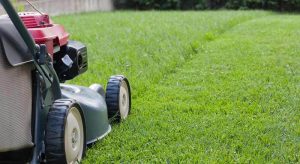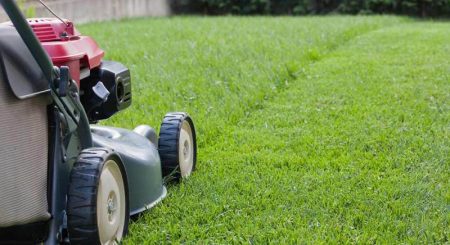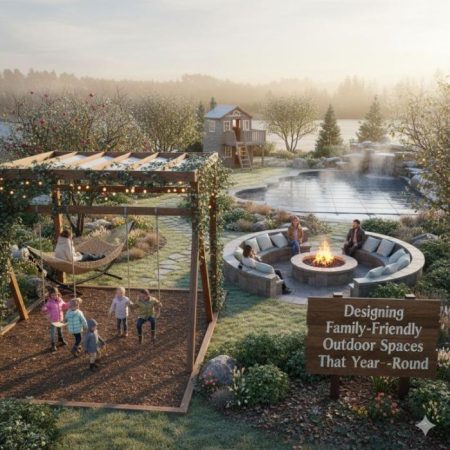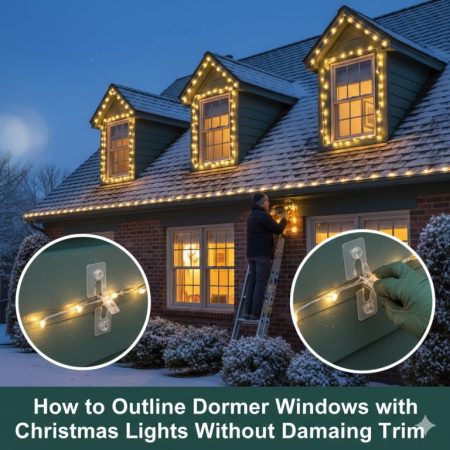When I first tried Board and Batten siding for my home project, I realized how beautiful, durable, and cost-effective this cladding solution truly is. This traditional construction style uses wide boards and narrow battens placed vertically to cover seams, giving wooden walls a textured, three-dimensional finish that compliments both interior and exterior design styles. Whether aiming for a rustic farmhouse aesthetic or a clean architectural treatment, the material is manufactured, tested, and approved to meet modern standards of sustainability and quality. Simple maintenance using a garden hose and tap helps in maintaining Board and Batten over time, extending its life while allowing creative trims, finishing pieces, and easy installation across various environments and opportunities.
What is Board and Batten?
Board and batten is a distinct siding technique characterized by wide vertical planks, known as boards, joined together and sealed at the seams by thinner vertical strips called battens. Traditionally, this method was used on barns and rural structures, utilizing simple, rough-sawn lumber to provide basic weather protection. Today, board and batten is an architectural choice valued for its striking visual depth, creating a rhythmic pattern of shadows and highlights across the facade. While historically made of wood, modern versions are commonly crafted from durable, low-maintenance materials like fiber cement, vinyl, or engineered wood, allowing it to be adapted for modern farmhouse, contemporary, and traditional home styles alike.
Board and batten siding
Board and batten siding is a timeless and versatile exterior design choice that offers both style and durability. It comes in various materials, including vinyl, fiber cement, wood, and metal board and batten, allowing homeowners to choose the perfect fit for their aesthetic and budget. Wood board and batten provides a traditional look, while metal board and batten offers modern durability. For those seeking low-maintenance options, engineered wood siding or smart side siding are popular choices that don’t compromise on style. This siding style is commonly used in modern farmhouse siding and rustic siding projects, giving your home a classic yet contemporary appeal.
When planning your project, it’s important to consider board and batten spacing and board and batten trim to achieve the desired vertical rhythm. This design feature creates a striking look, especially when combined with board and batten patterns that offer a unique twist. For homeowners looking to enhance their interiors, interior board and batten can be applied to accent walls, creating a warm and welcoming atmosphere. The right board and batten colors, such as dark board and batten or white board and batten exterior, can completely transform your space, giving it a fresh, modern vibe.
For those looking to take on a DIY board and batten project, there are many board and batten ideas available to help guide you through the installation process. Whether you’re installing it on your exterior wall cladding or creating a stylish accent wall inside, board and batten adds both texture and character. The board and batten installation process can be straightforward, especially with proper planning and attention to detail. You’ll also want to be mindful of the board and batten cost and ensure you’re selecting materials that fit your budget without compromising quality.
In addition to its beauty, board and batten wainscoting offers an elegant touch to interior rooms, adding depth and dimension. Whether you’re opting for a cottage siding look or incorporating transitional siding elements, this siding style remains a popular and versatile choice for various home designs.
Why Homeowners Love This Timeless Siding
When I first explored board and batten siding, I was amazed at how this traditional yet adaptable solution could completely enhance a home’s exterior. Its method of wide boards paired with narrow battens not only adds texture but also gives a sense of timeless elegance that few options can match. One of the biggest advantages I found was its durability it stands strong through seasons while staying stylish. Beyond looks, the useful benefits of insulation and easy maintenance make it a smart investment. Every time I see this siding on a home, I’m reminded how effortlessly it blends beauty and practicality, making it a perfect solution for modern living.
Unique Charm and Visual Appeal
From my experience working with home exteriors, board and batten siding instantly gives a home a traditional yet modern touch that feels both cozy and elegant. The vertical lines formed by wide boards and narrow battens create a rhythmic texture that draws the eye and adds depth to any surface. This design not only enhances aesthetic appeal but also brings warmth and character, making it a favorite for farmhouses and modern architecture alike. Its rustic charm blends old-world beauty with new-age style, creating an eye-catching look that never goes out of fashion.
Long-Lasting Strength and Protection
In my years of helping homeowners choose the right exterior finishes, I’ve found that durability truly defines the value of board and batten siding. When built with high-quality materials like fiber cement, this siding can withstand heavy rain, snow, and UV rays without losing its charm. Expertly crafted panels stay protected even in the harshest weather conditions, ensuring your home remains beautiful for many years. I’ve seen how investing in these reliable materials not only enhances appearance but also brings peace of mind knowing your home’s exterior is built to last through changing climates and seasons.
Unique Design
Board and Batten siding offers exceptional design versatility, making it a popular choice for both homeowners and designers. It allows for endless customization with a wide variety of colors and profiles, ensuring every project gets a unique, modern look. The battens add a decorative touch, enhancing the overall appeal. By adjusting panel spacing, you can create a more creative and personalized exterior to match your style. Whether you prefer a sleek, minimalist feel or a more expressive and decorative finish, Board and Batten siding provides a perfect solution for customization. It’s ideal for anyone looking for a wider range of possibilities to suit different design tastes and preferences.
Board and Batten Siding: Low Maintenance Benefits
Board and Batten siding offers low maintenance for homeowners looking to reduce the hassle of regular upkeep. Unlike traditional wood siding, fiber cement panels are highly resistant to rot and pests, making them a durable choice for any climate. This siding material requires much less attention over time, allowing you to spend more time enjoying your home. The weather resistance also adds to its longevity, reducing the need for frequent repairs or refinishing. With minimal maintenance required, you can have peace of mind knowing your siding is built to last, keeping your home looking great for years to come.
The Longevity of Board and Batten Siding
Board and Batten siding is known for its longevity, offering a robust solution for homeowners seeking a siding that lasts. With durable materials like fiber cement or treated wood, this siding resists warping, cracking, and shrinking, ensuring your home stays protected and beautiful for decades. The construction of Board and Batten ensures that the panels remain strong and lasting, even in harsh weather conditions. This protection adds value to your home, as you won’t need to replace or repair the siding often. With proper care, the beauty and strength of Board and Batten can continue to enhance your home for many years.
Increasing Property Value with Board and Batten Siding
Investing in Board and Batten siding can significantly boost the value of your home. Its classic, timeless look adds charm and enhances curb appeal, making your property more attractive to potential buyers. This durability ensures the siding lasts for many years, which is a key selling point in the competitive real estate market. Not only does it improve the exterior, but it also strengthens the home’s property value, making it a wise choice for homeowners looking to maximize their return on investment. The distinctive beauty of Board and Batten appeals to a wide range of buyers, ensuring your home stands out.
Board and Batten Siding Costs
When it comes to board and batten siding, understanding the costs is key. The installation costs will depend on both materials and labor. On average, homeowners spend between $10.50 and $13.90 per square foot for professional installation. The total cost for a 2,000 square foot house can vary based on material choices. For instance, wood tends to be more expensive than other materials like vinyl or engineered wood. Additionally, labor costs can increase if the installation requires customizations. Popularity and material preferences have influenced prices in recent years, with wood siding seeing a higher percentage of cost increase compared to other options. The choice of materials is often driven by style and durability.
Materials and Installation Costs
When homeowners are considering board and batten siding, understanding the costs of materials and installation is crucial. On average, spending for professional installation ranges between $10.50 and $13.90 per square foot. For a 2,000 square foot house, this adds up to a significant total cost. The cost will vary depending on the materials chosen wood typically being more expensive than options like vinyl or engineered wood. Over the past year, popularity of certain materials has driven a percentage increase in prices. As board and batten siding continues to rise in popularity, it’s important to know that material choices will directly affect the cost, with more premium options increasing the overall expenses.
Impact of Material Choices on Board and Batten Siding Costs
The material you choose for board and batten siding has a significant impact on both the costs and the look of your home. Wood is a traditional and popular choice, but it tends to be more expensive compared to options like fiber cement, metal, or vinyl. Engineered wood offers a middle ground with lower costs and similar aesthetics. For installation, additional expenses may include flashing, moisture-resistant barriers, trim pieces, caulk, nails, and finishing materials like paint or stain. Costs per square foot can vary, with wood being the highest and vinyl or fiber cement often costing less. The material choice directly affects long-term durability and maintenance needs, making it crucial to balance costs and aesthetic appeal.
Labor and Customization Costs for Board and Batten Siding
When installing board and batten siding, labor costs can vary depending on the customizations needed. For instance, cutting vinyl or material to specific sheet sizes or shapes for a custom look can add to the costs. Replacing or removing old siding also increases the overall labor expenses. Extra work may be required for custom cuts or adjustments to ensure a perfect fit on the exterior of the home. Additionally, certain customizations like special finishes or trim can add to the overall costs. When considering a replacement or customization, it’s important to factor in both materials and labor to get an accurate estimate.
How to Use Board and Batten Siding
For a homeowner or DIY enthusiast, installing board and batten siding can be a rewarding project to achieve a personalized aesthetic for your exterior. To get started, you’ll need to decide on the materials you want to use, such as wood, vinyl, or engineered wood, and determine the batten spacing that suits your desired look. With a clear understanding of how to install each board and batten, you can create a beautiful new facade. By following step-by-step instructions and measuring carefully, you’ll be able to achieve the look you’ve always wanted, transforming your home with a modern and clean finish.
BOARD AND BATTEN SIDING IDEAS
Warm Rustic Charm with Earth Tones

This visual captures a home exuding inviting rustic charm by utilizing board and batten in a rich, sun-baked terracotta hue. The deep, warm color complements the natural surroundings, especially during autumn. The vertical lines of the siding contribute to a sense of welcoming solidity, framed by darker window shutters and a robust wooden porch, grounding the structure firmly within its natural landscape.
Sleek Coastal Contemporary
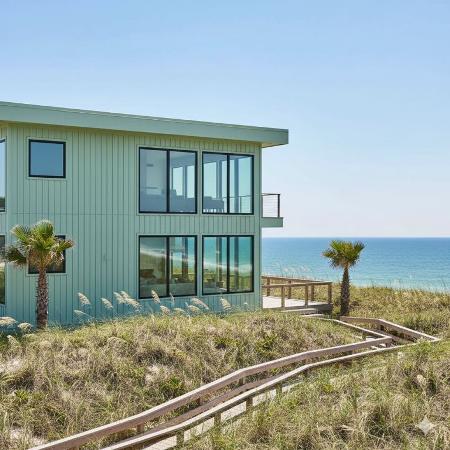
This image presents a modern coastal residence where board and batten siding is rendered in a refreshing, muted sage green. This choice harmonizes effortlessly with the expansive ocean backdrop, creating a serene yet sophisticated presence. The clean, unadorned vertical panels accentuate the home’s contemporary lines and numerous large windows, allowing the architecture to blend seamlessly with its breathtaking natural environment.
Urban Industrial Edge
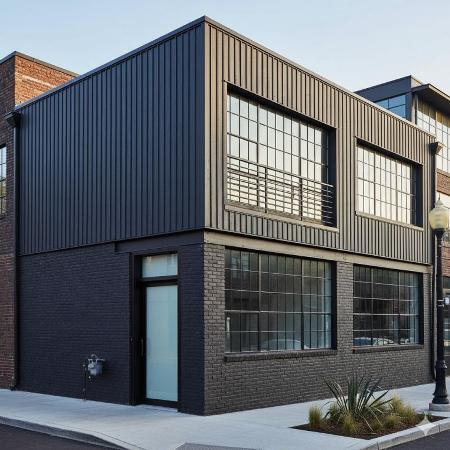
This perspective showcases board and batten siding used in an urban industrial context. The deep, almost black, color and sharp vertical lines of the siding contribute to a robust, modern aesthetic, often seen in revitalized loft spaces or commercial buildings. Paired with dark brickwork and large, multi-pane windows, this application of board and batten helps define a strong, no-nonsense architectural identity in a bustling city environment.
Charming Cottage with Soft Pastels
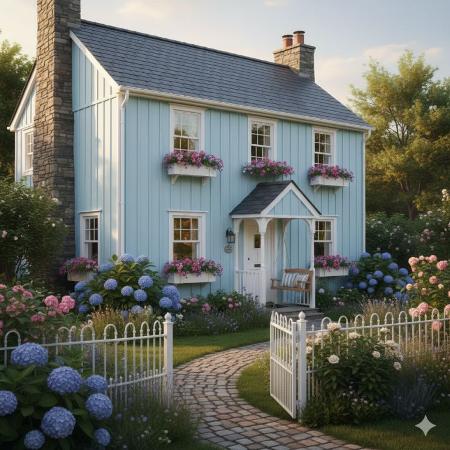
Board and batten siding transforms a house into a picturesque cottage, rendered in a gentle, sky-blue pastel. This softer color choice evokes a sense of tranquility and whimsy, perfectly complemented by lush, vibrant garden blooms and traditional window boxes. The vertical panels provide a clean, storybook quality to the home, enhancing its inviting and idyllic appeal, making it a charming focal point within a flourishing landscape.
Mountain Retreat with Forest Green Accents
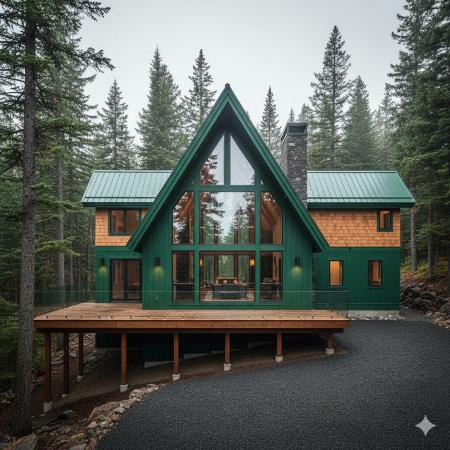
This image showcases a striking mountain sanctuary where board and batten siding is used prominently in a deep, verdant forest green. This rich color scheme allows the home to integrate seamlessly into its dense woodland setting. The vertical lines of the siding contribute to the impressive height of the central A-frame, while natural wood shingles on other sections add textural variety and warmth, creating a sophisticated cabin aesthetic.
Mediterranean-Inspired Terracotta Hues
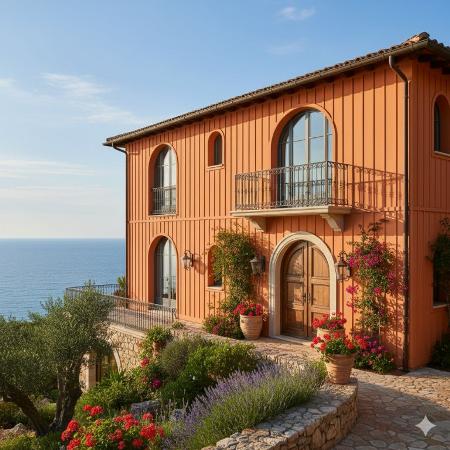
Evoking the sun-drenched coasts of the Mediterranean, this home features board and batten siding in a vibrant terracotta orange. The vertical panels lend a structured elegance to the facade, beautifully complementing the classic arched windows and doorways. Lush climbing bougainvillea and potted plants add splashes of color, creating a warm, inviting atmosphere that feels perfectly at home overlooking the sparkling sea.
Modern Desert Oasis with Warm Neutrals
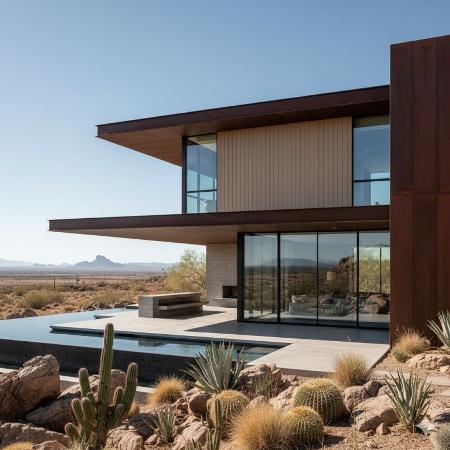
This striking home, set within a vast desert landscape, uses board and batten siding in a sophisticated light beige neutral. The subtle vertical texture provides a contemporary contrast to the rugged natural surroundings. Combined with expansive glass panels and elements of weathered corten steel, the siding contributes to an architectural style that is both minimalist and deeply connected to its arid environment.
Nordic-Inspired Grey with Natural Wood
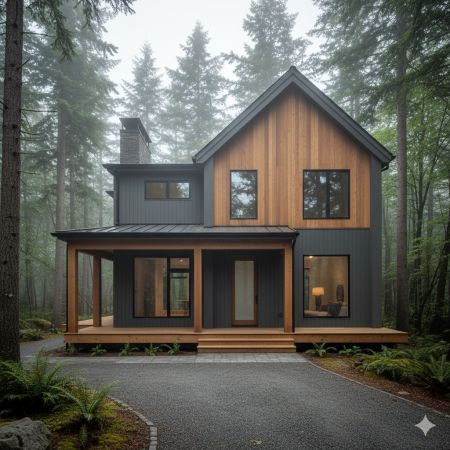
This design beautifully blends modern aesthetics with natural warmth, featuring board and batten siding in a deep, sophisticated charcoal grey. This striking dark base is thoughtfully contrasted with generous sections of warm, vertical natural wood paneling, particularly on the upper gables. The combination creates a clean, contemporary cabin feel that is both refined and harmoniously integrated into its misty, forested backdrop, reminiscent of Nordic design.
Vibrant Lakehouse in Cerulean Blue
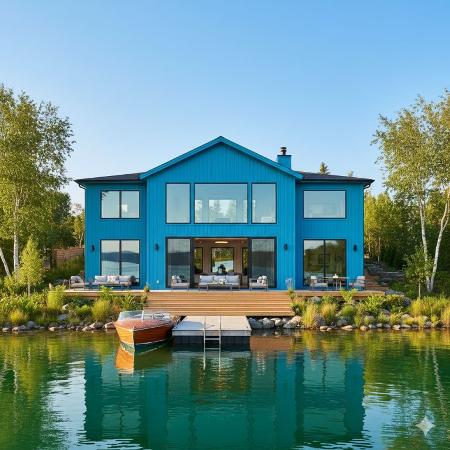
This stunning lakefront property makes a bold statement with board and batten siding painted in an energetic cerulean blue. The vibrant hue mirrors the clear sky and tranquil waters, creating a joyful and cohesive outdoor living experience. The vertical lines of the siding contribute a sense of grandeur to the home’s broad facade, perfectly complementing the expansive windows and a spacious deck that steps directly onto the water.
Elegant Coastal Home with Classic Navy
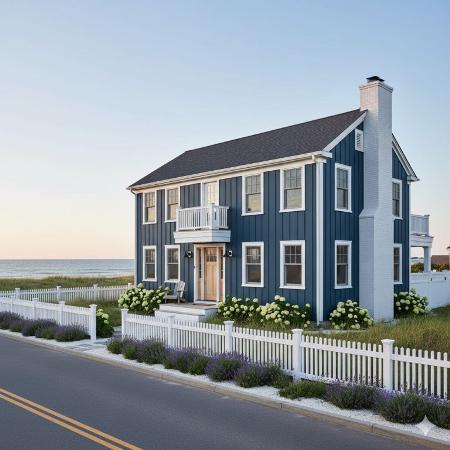
This charming coastal dwelling showcases board and batten siding in a timeless and sophisticated classic navy blue. The deep blue hue is elegantly contrasted by crisp white trim around the windows, door, and a traditional picket fence, creating a quintessential seaside appeal. The vertical lines add a tailored yet inviting character to the home, perfectly positioned to enjoy ocean views and framed by soft, low-maintenance landscaping ideal for a beachfront setting.
Unique Board and Batten Interior Wall Ideas
Elegant Entryway Accent in Soft Gray

This image features a sophisticated application of board and batten paneling in an entryway or hallway, painted in a calming soft gray. Extending about two-thirds up the wall, it creates a wainscoting effect that adds architectural depth and texture to an otherwise simple space. A natural wood ledge atop the paneling offers a functional surface for decor, tying together the refined vertical lines with practical style.
Dramatic Bedroom Feature Wall
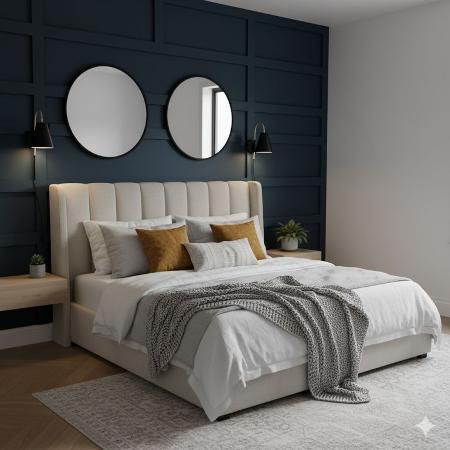
In this bedroom, board and batten transforms a wall into a striking feature behind the bed. The deep navy blue paint choice for the paneling creates an immediate sense of luxurious drama, drawing the eye and providing a plush backdrop for the headboard. The pattern extends floor-to-ceiling, giving the room an enveloping, tailored feel that exudes modern comfort and elegance.
Playful Kids’ Room with Two-Tone Styling
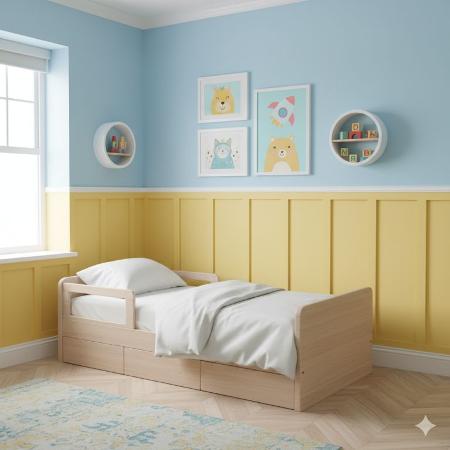
This vibrant children’s room utilizes board and batten to introduce a cheerful, two-tone design. The lower half of the wall features the paneling in a sunny yellow, adding playful texture and grounding the space. Above, a soft blue paint creates a light, airy feel. This combination defines distinct visual zones while maintaining a cohesive and inviting atmosphere perfect for a child’s sanctuary.
Sophisticated Dining Room Texture
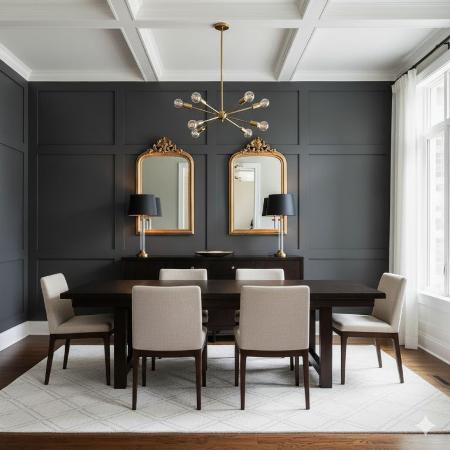
This image showcases a formal dining room transformed by floor-to-ceiling board and batten paneling painted in a luxurious, deep charcoal. The meticulous grid pattern adds immense architectural character and a sense of refined grandeur to the space. Complemented by ornate gold mirrors and elegant lighting, this textured wall treatment elevates the room, creating an atmosphere of sophisticated intimacy perfect for entertaining.
Cozy Reading Nook with Integrated Seating
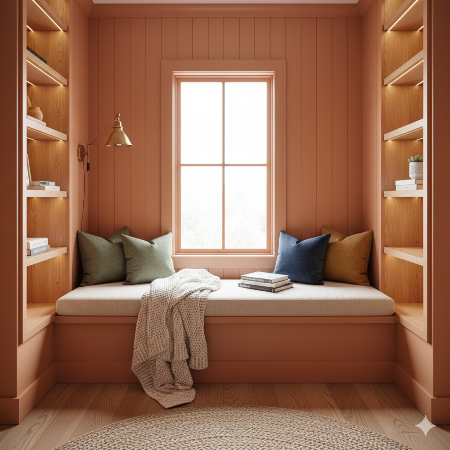
This inviting image features board and batten paneling in a warm, muted terracotta shade, creating a snug and charming reading nook. The paneling runs seamlessly behind a built-in window seat, providing both visual interest and a cozy backdrop. Flanked by integrated bookshelves with soft lighting, the vertical lines of the board and batten contribute to an enveloping, custom-built feel that makes this corner a perfect retreat.
Board and Batten Siding and Wall FAQs
Q1: How does the construction of contemporary Board and Batten differ from the method used historically?
A: Historically, the board and batten system was purely utilitarian: the thinner battens were strictly required to cover the exposed gaps between wide, shrunken boards, making the structure weather-tight. Today’s approach is mainly decorative and aesthetic. Installers typically secure the battens onto a solid, continuous substrate (like sheathing or smooth siding). This shift means the style is now chosen for its strong visual texture and rhythmic shadow lines, rather than being a necessary method for rudimentary weatherproofing.
Q2: I want an interior accent wall. How can I use Board and Batten without creating a purely rustic or “farmhouse” look?
A: To lend an air of modern sophistication, focus on color saturation and pattern density. Steer clear of traditional white or cream. Instead, select an assertive, deep color (such as black, dark teal, or forest green). Also, use narrower battens and position them with closer spacing. This creates a dense, textural wall treatment that feels more like refined contemporary paneling than a country wall siding.
Q3: What are the best non-wood materials for exterior Board and Batten siding that offer low maintenance?
A: For lasting exterior applications, professionals often turn to non-wood alternatives designed for resilience:
- Fibre Cement: This material is exceptionally durable, non-combustible, and provides excellent paint retention. It can be manufactured in precise widths and is entirely resistant to insect damage and decay.
- Vinyl: An economical and lightweight option, vinyl demands very little maintenance. While easy to install, design flexibility may be limited as it is usually available in fixed batten widths.
- Engineered Wood Composites: These products are increasingly used for the underlying ‘boards.’ They offer superior stability compared to natural lumber, reducing the risk of the warping and movement that can create gaps.
Q4: When installing interior wainscoting that stops halfway up the wall, is a top trim piece essential?
A: Integrating a horizontal cap piece, or a rail, at the terminus of the paneling is highly advisable. While functionally optional, this rail is crucial for visual finesse. It serves as a decorative ledge, cleanly defining the transition point between the textured paneling and the upper wall. Architecturally, it gives the installation a final, complete look and shields the cut edges of the battens.
Q5: Is the vertical orientation the only way to apply the Board and Batten style?
A: No, the concept of covering seams with strips can be creatively reinterpreted for modern interiors:
- The Full Grid: Battens are applied both vertically and horizontally to form a symmetrical grid of squares or rectangles. This creates the classic look of traditional recessed box paneling, suitable for dining rooms or libraries.
- Angular and Diagonal Patterns: For a powerful focal point, battens can be set at sharp, contrasting angles (like 45 degrees) or arranged in a herringbone pattern. This technique adds dynamic movement to the wall surface, perfect for contemporary feature walls.



